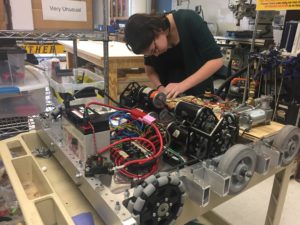Sarah Berg
Staff Writer

Engineering and Robotics is one of the most prominent clubs at SLA, owing to its competitive element, the camaraderie built between teammates, and the opportunity to build something spectacular. However, an element of stress is also a key component of the club, especially right now. Build season is coming to a close.
The club participates in the FIRST (For Inspiration and Recognition of Science and Technology) Robotics Competition (FRC), and each year works to build a robot that will compete in the tournament. The competition’s build season begins each year on the first Saturday of January.
Junior Bronwyn Goldschneider joined this year and is treasurer of the club. She described the start of build season as a “meeting at Penn where the structure of the game is released”. The game that Goldschneider references is based on a task that a robot must be able to do, such as throw a ball into a hoop or over a wall.
Junior and Chief Systems Engineer Kamil Kielar pointed out that the most difficult part of these competitions is the fact that with every year comes a different game. Subsequently, the team must build an entirely new robot each year.
After the game is revealed, the club gets six weeks to build the robot. Kielar described these weeks as a “very intense time”. He added, “we’re on week six right now, crunch time. At the moment we have a running drivetrain and prototypes for a lot of our mechanisms, but we’re still finalizing their designs, so we’re a little behind.”
In hopes of catching up, the club has been meeting almost every single day. “Last week, we were here on Monday, Tuesday, Thursday, Friday till 8:00, Saturday from 10:00 to 5:00, and Sunday from 10:00 to 4:00. This Monday, we stayed till around 8:00, and it’s going to be like that until the end of the season,” listed Kielar. Several years ago, a team even stayed in school until midnight.
In terms of success in FRC this year, the team is hopeful yet realistic. Goldschneider thinks that the chances of winning are “better than last year, but not certain,” and Kielar believes, “we just have to put our minds to it, really get the mechanisms done, and just put it together. I think we have a good chance.”
Leave a Reply